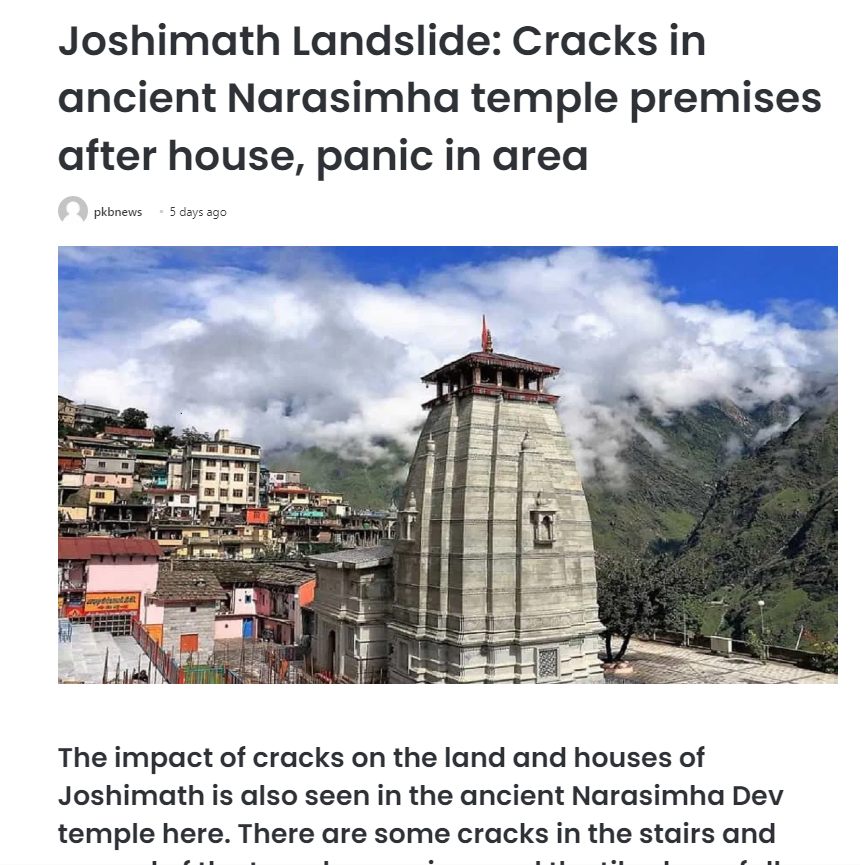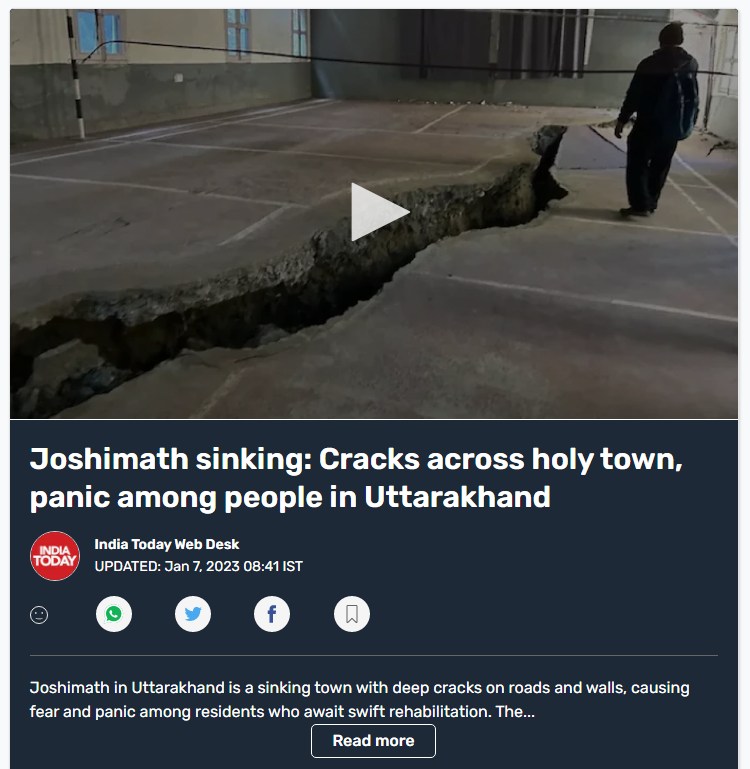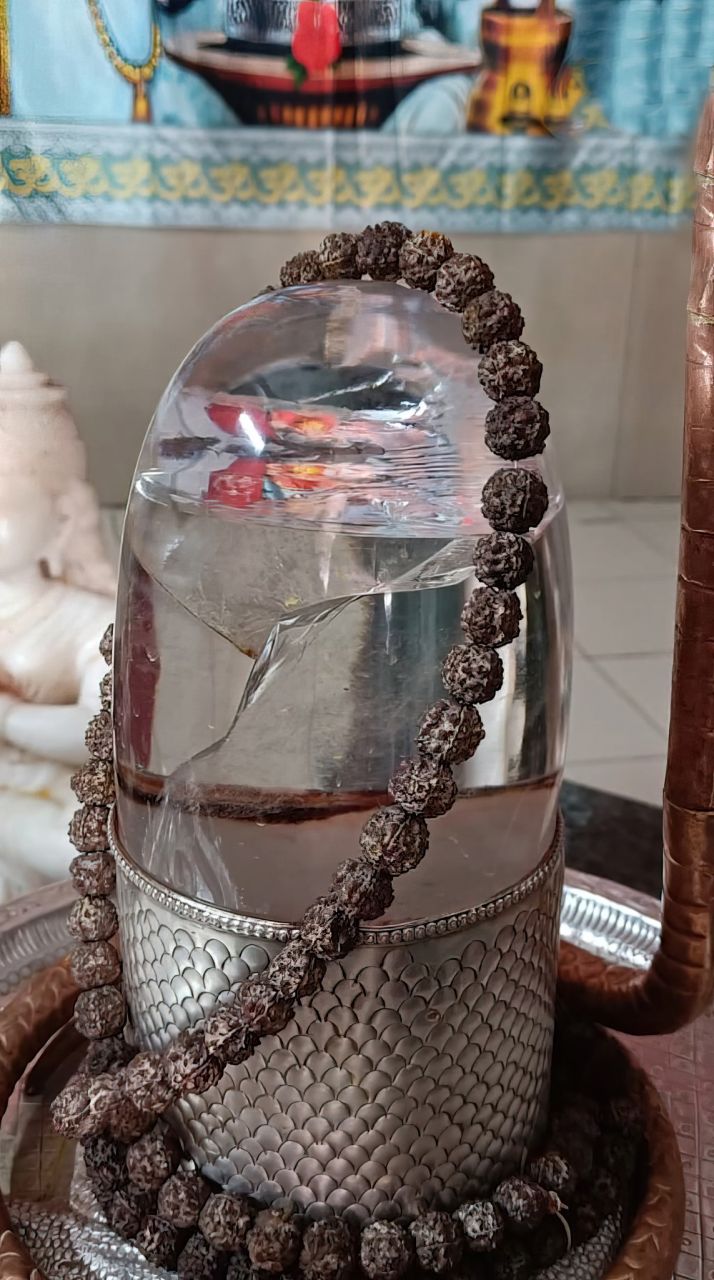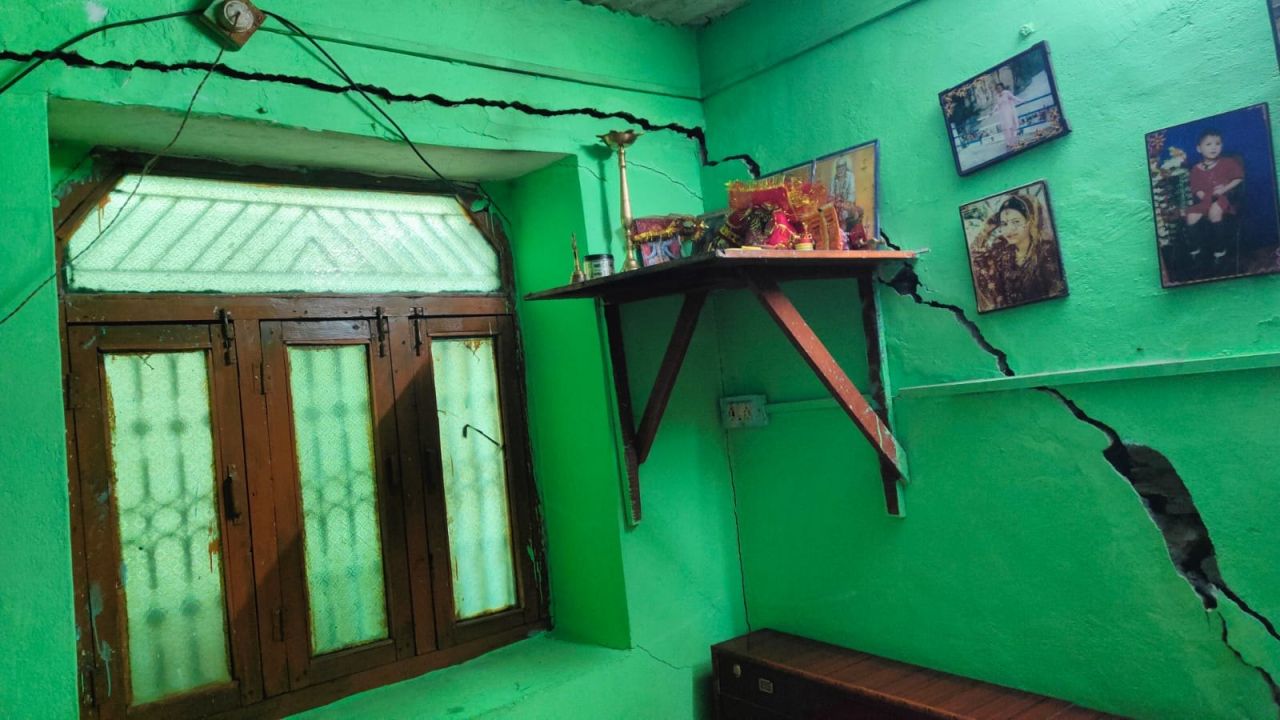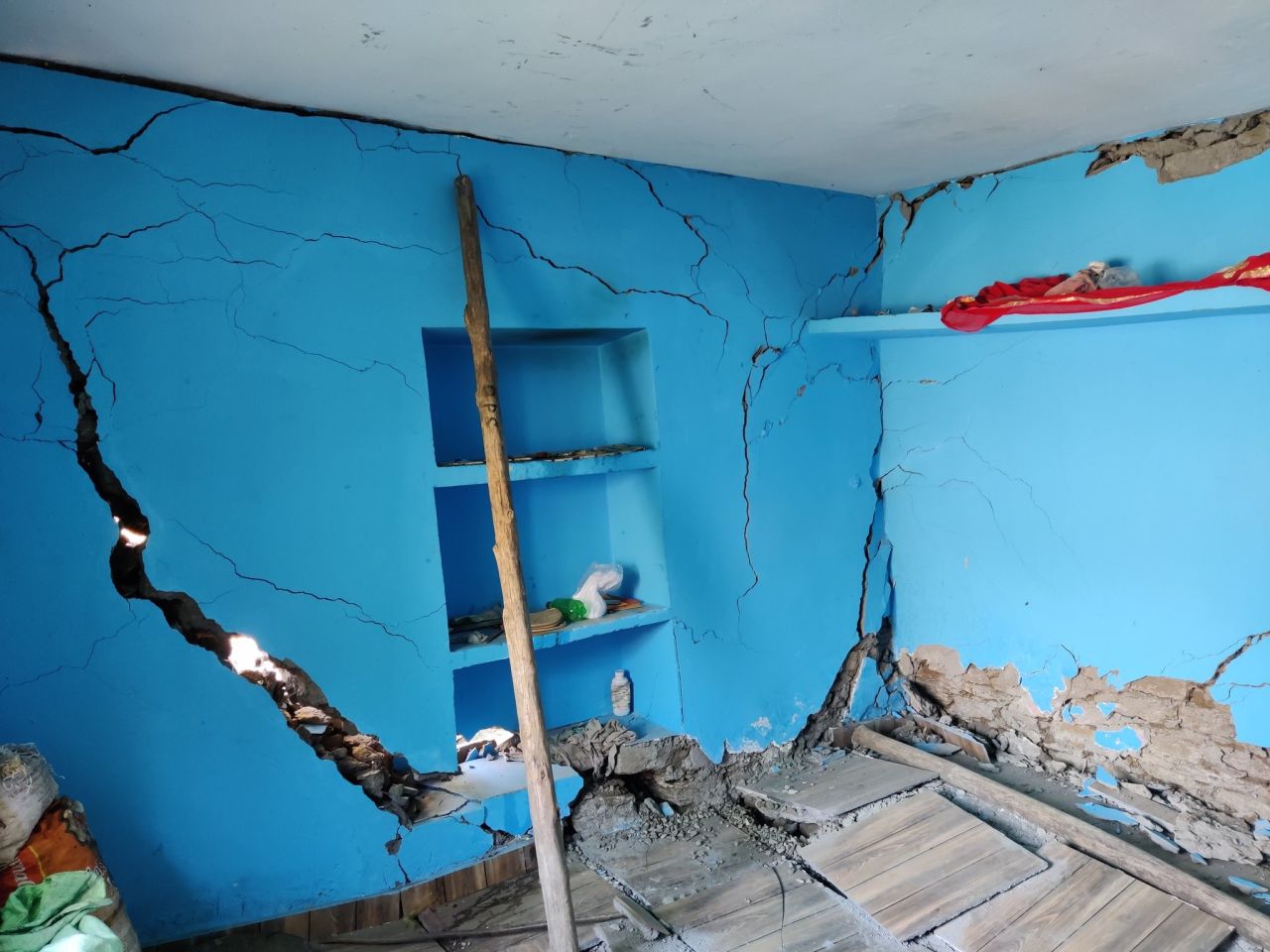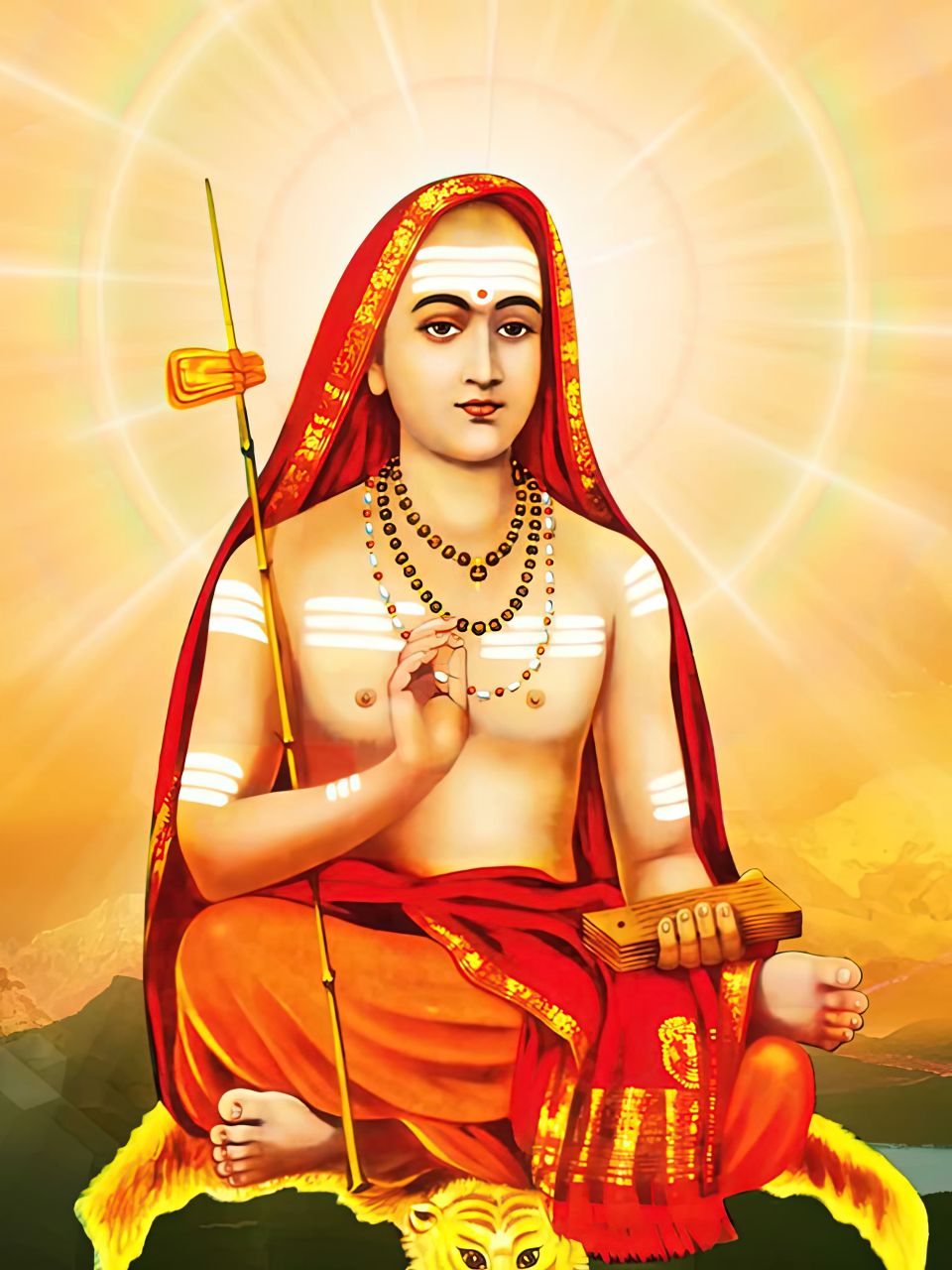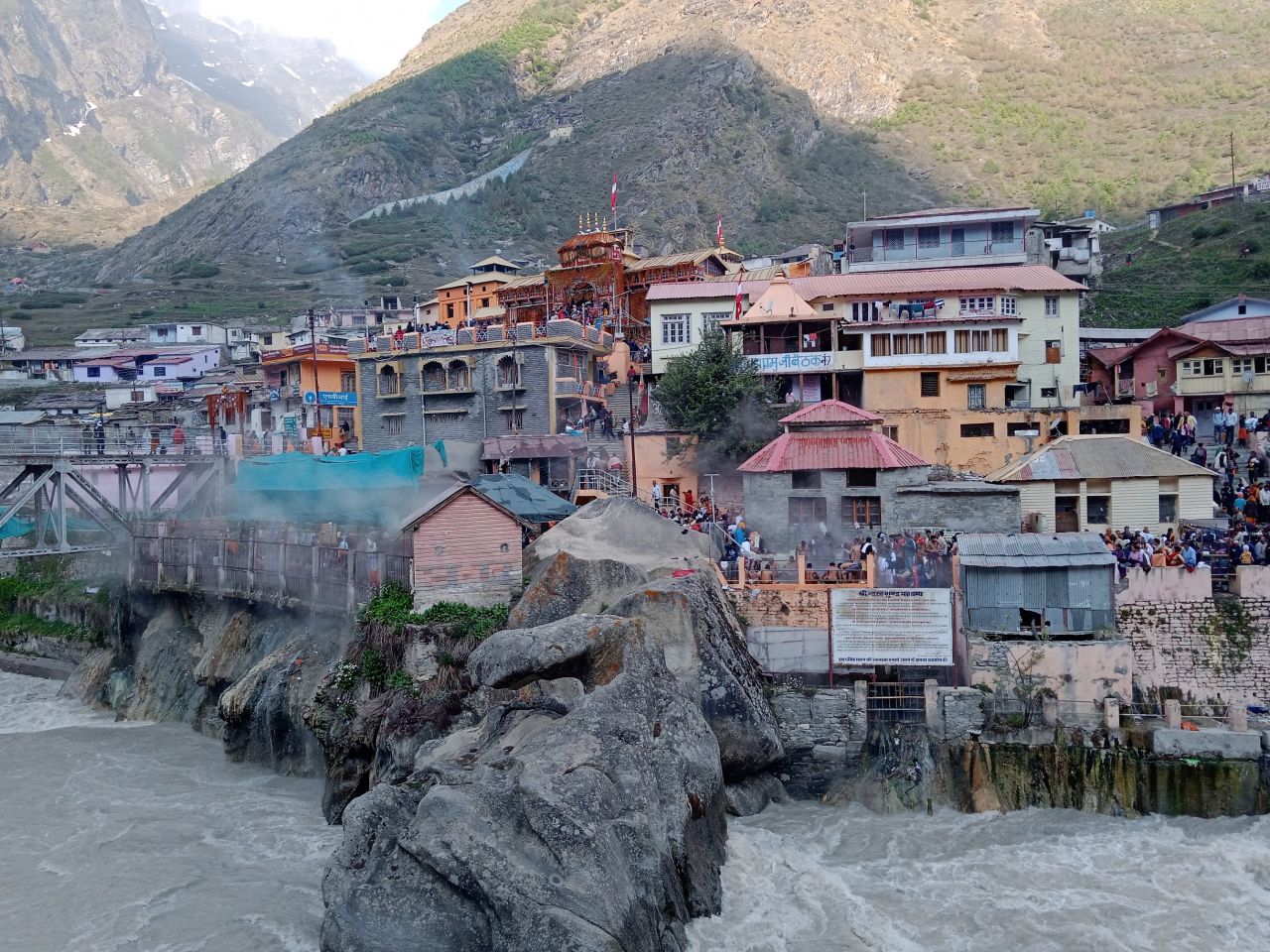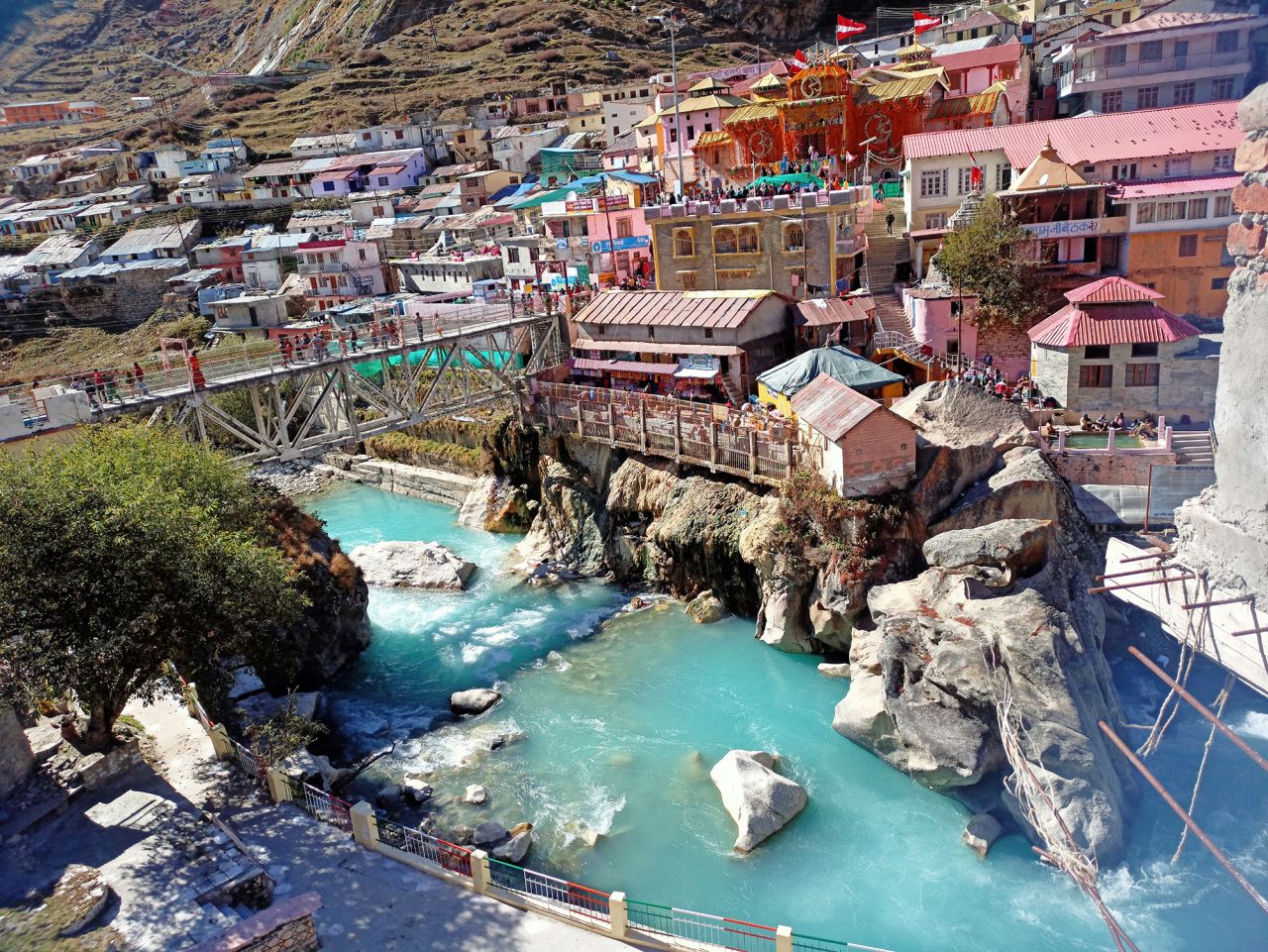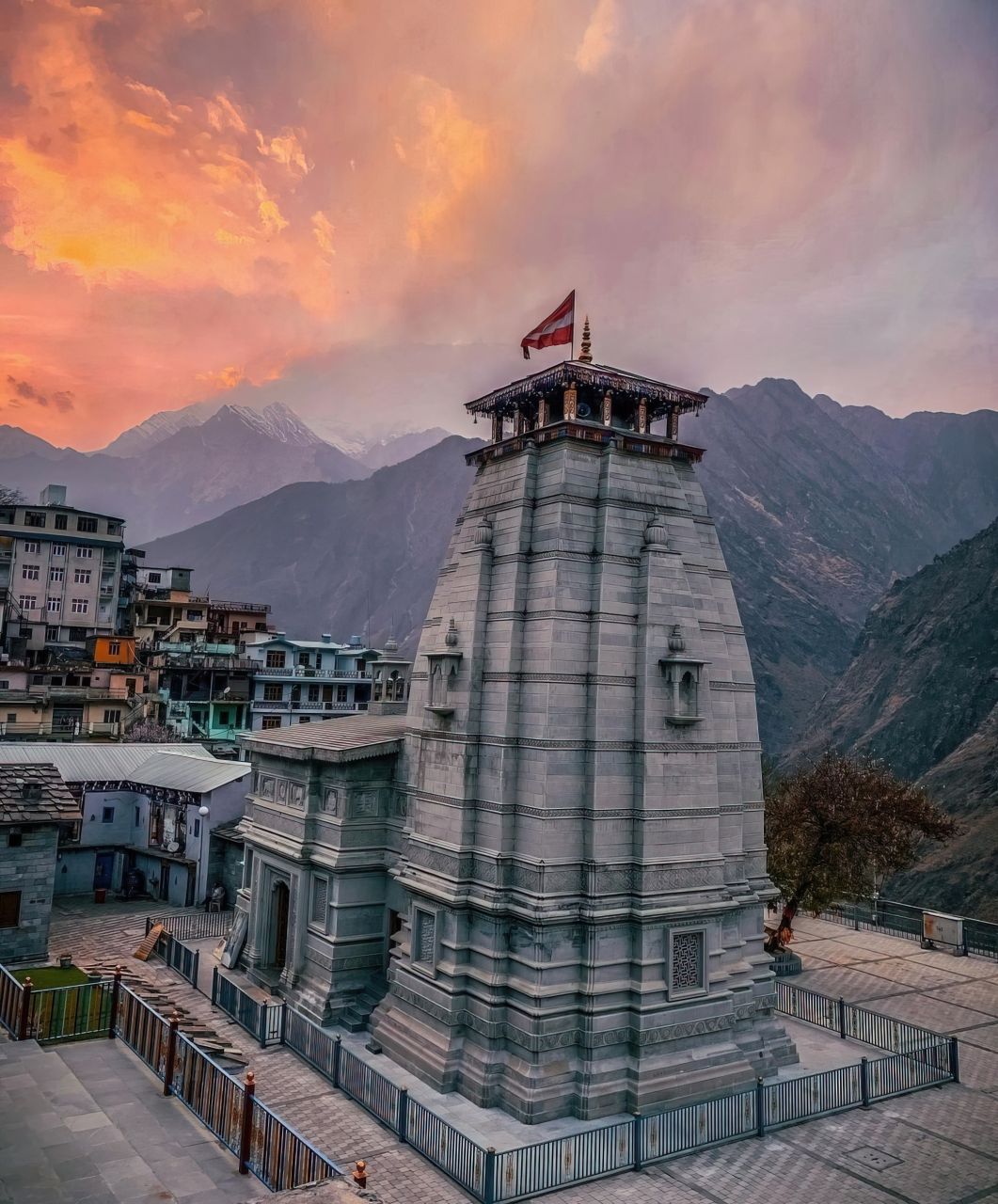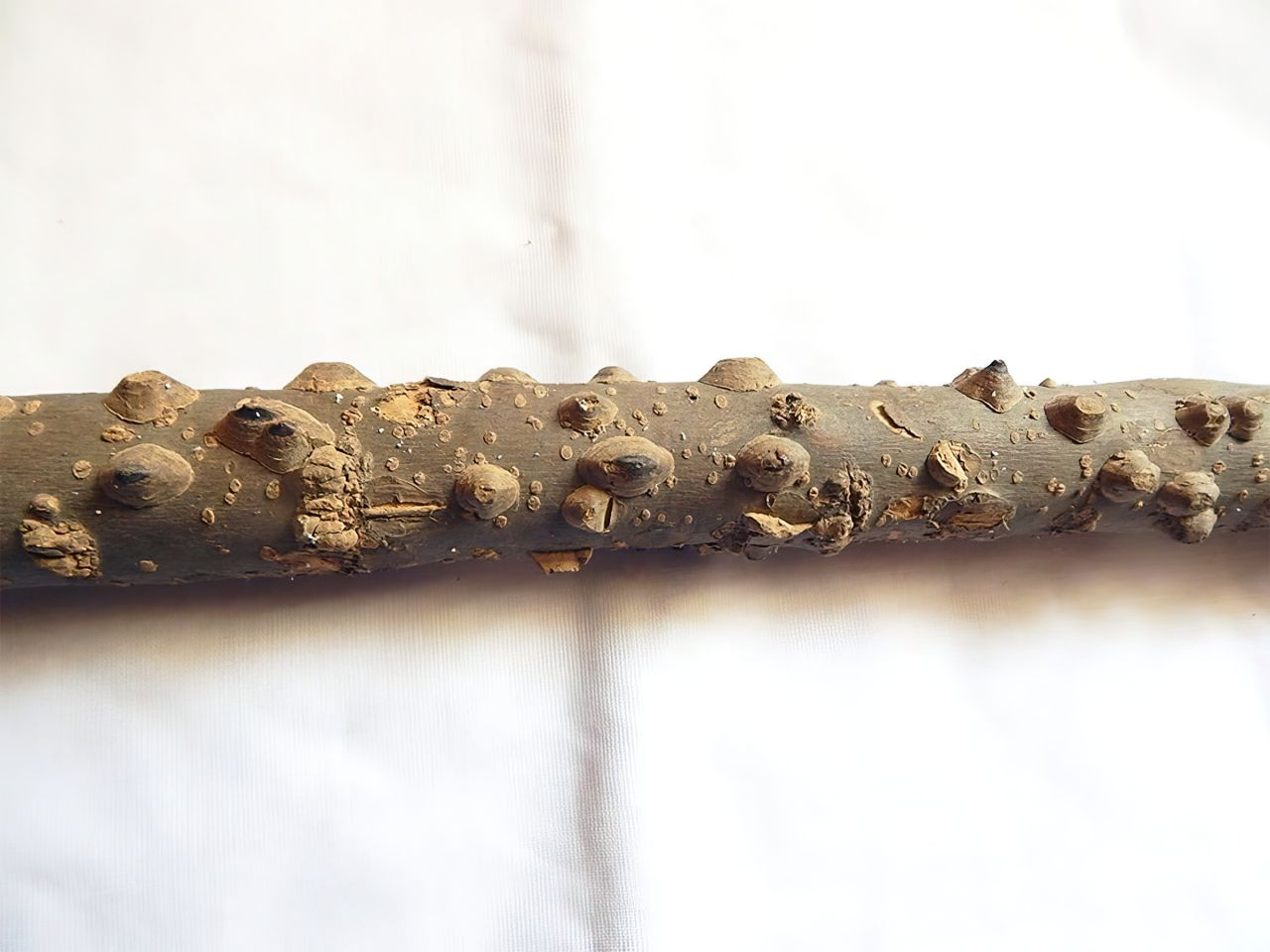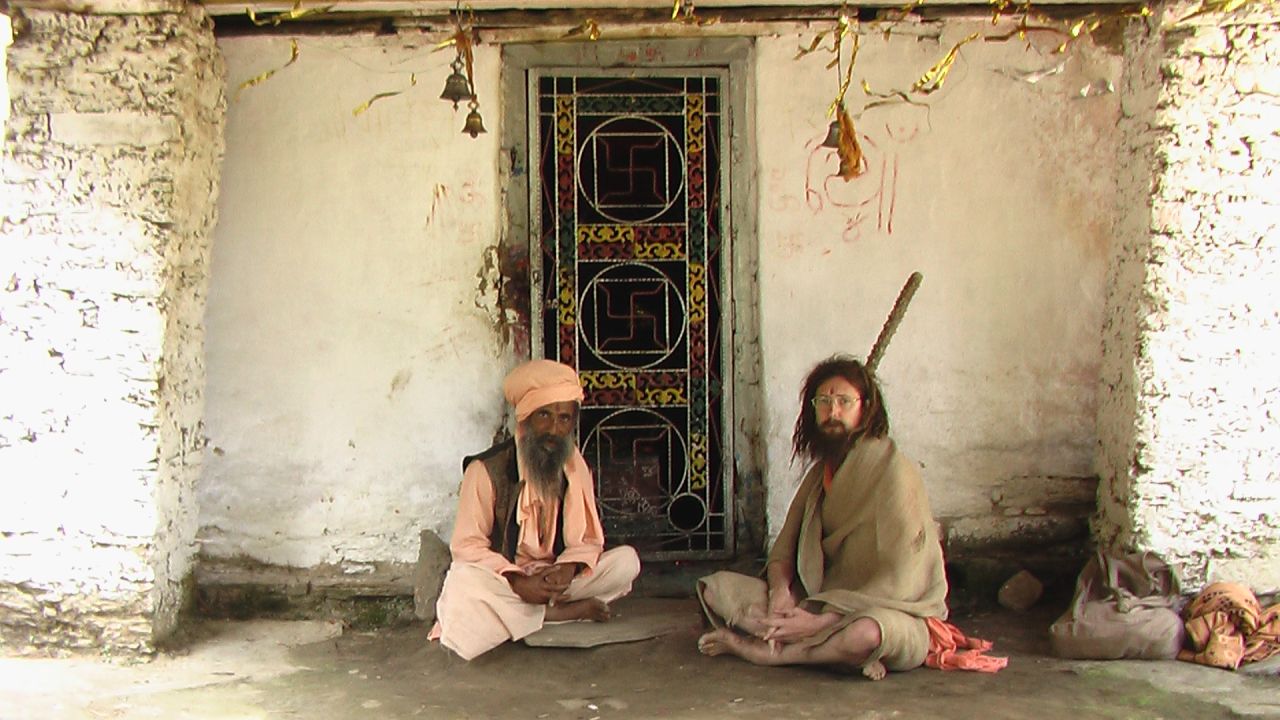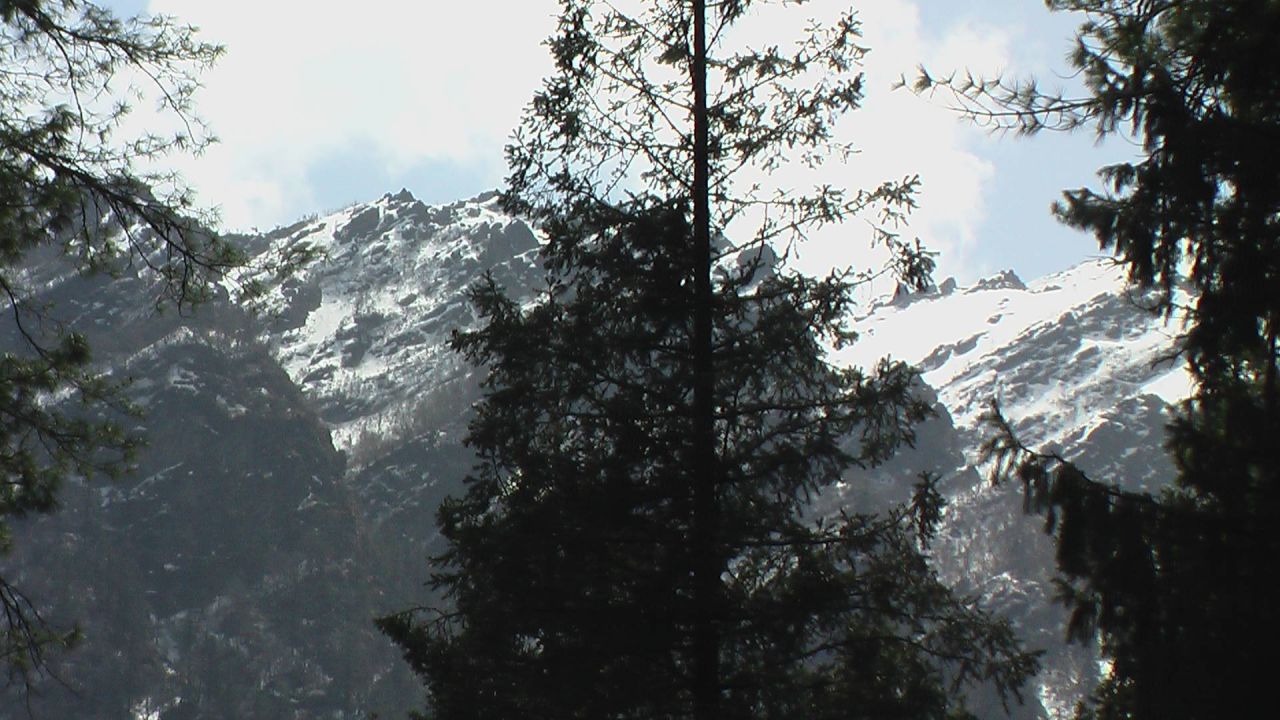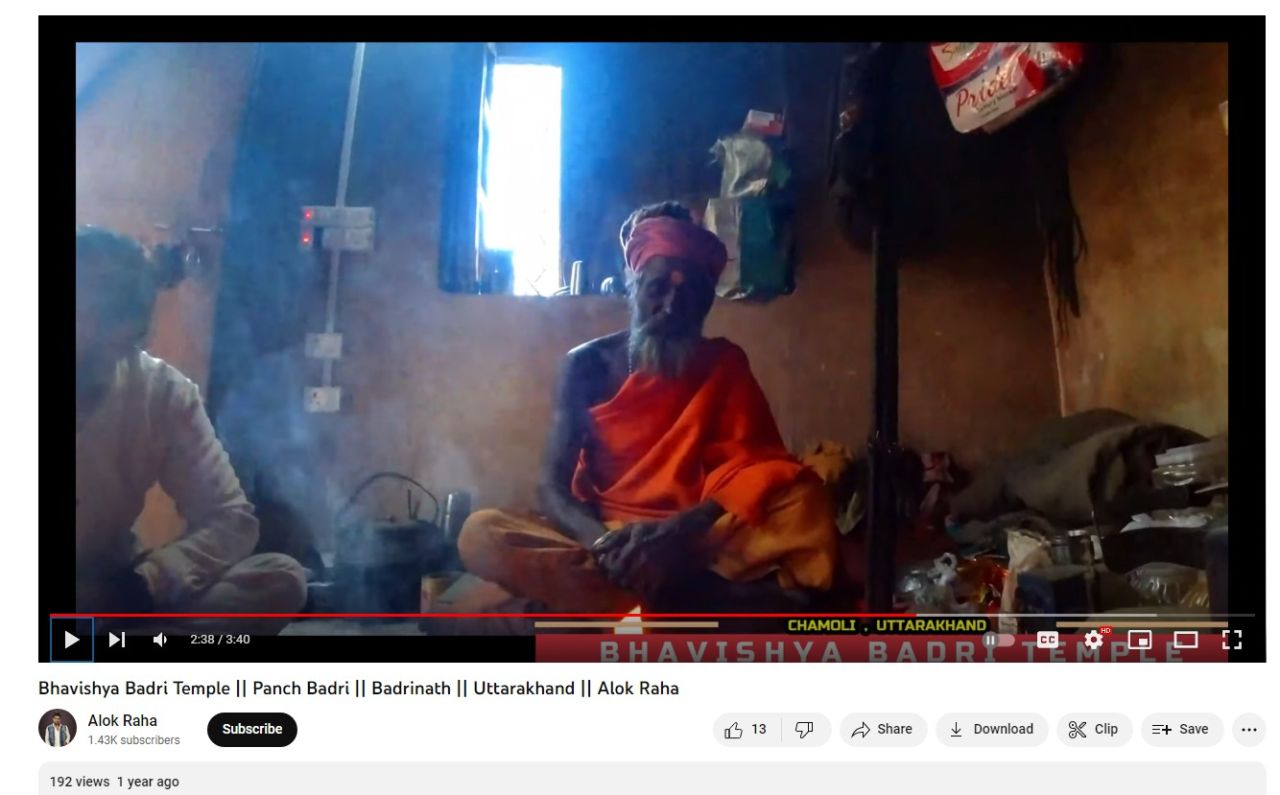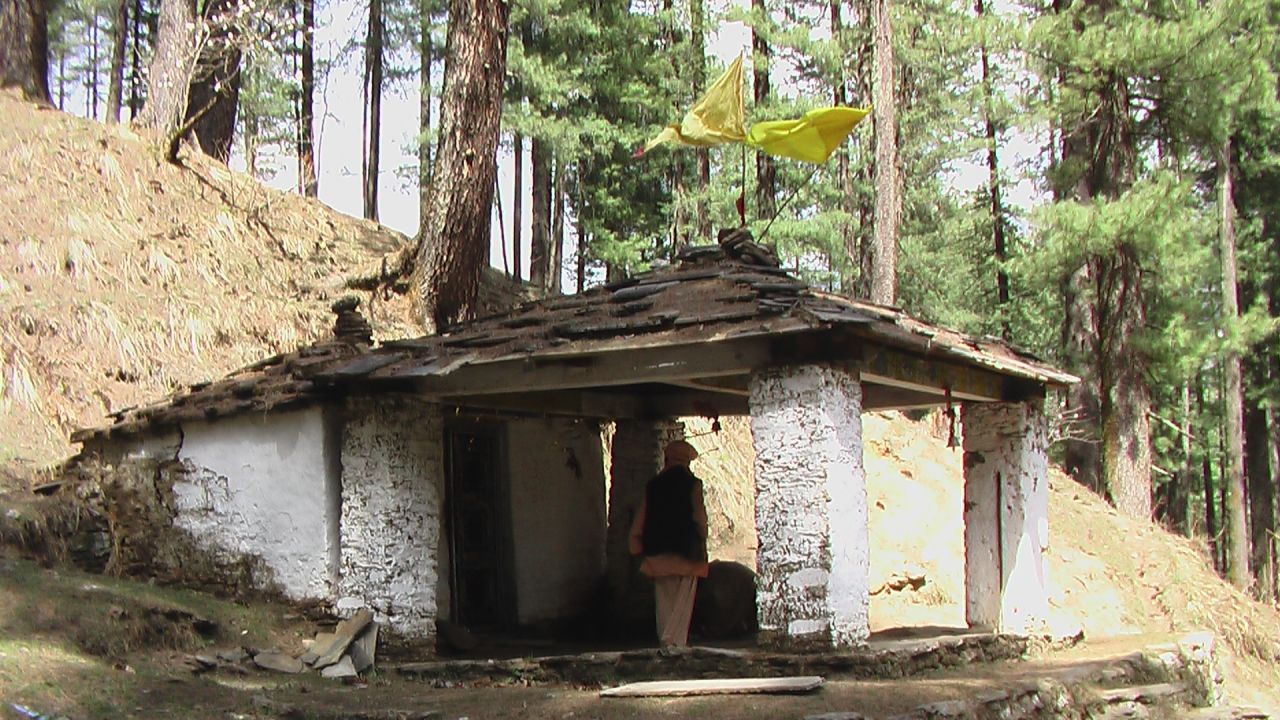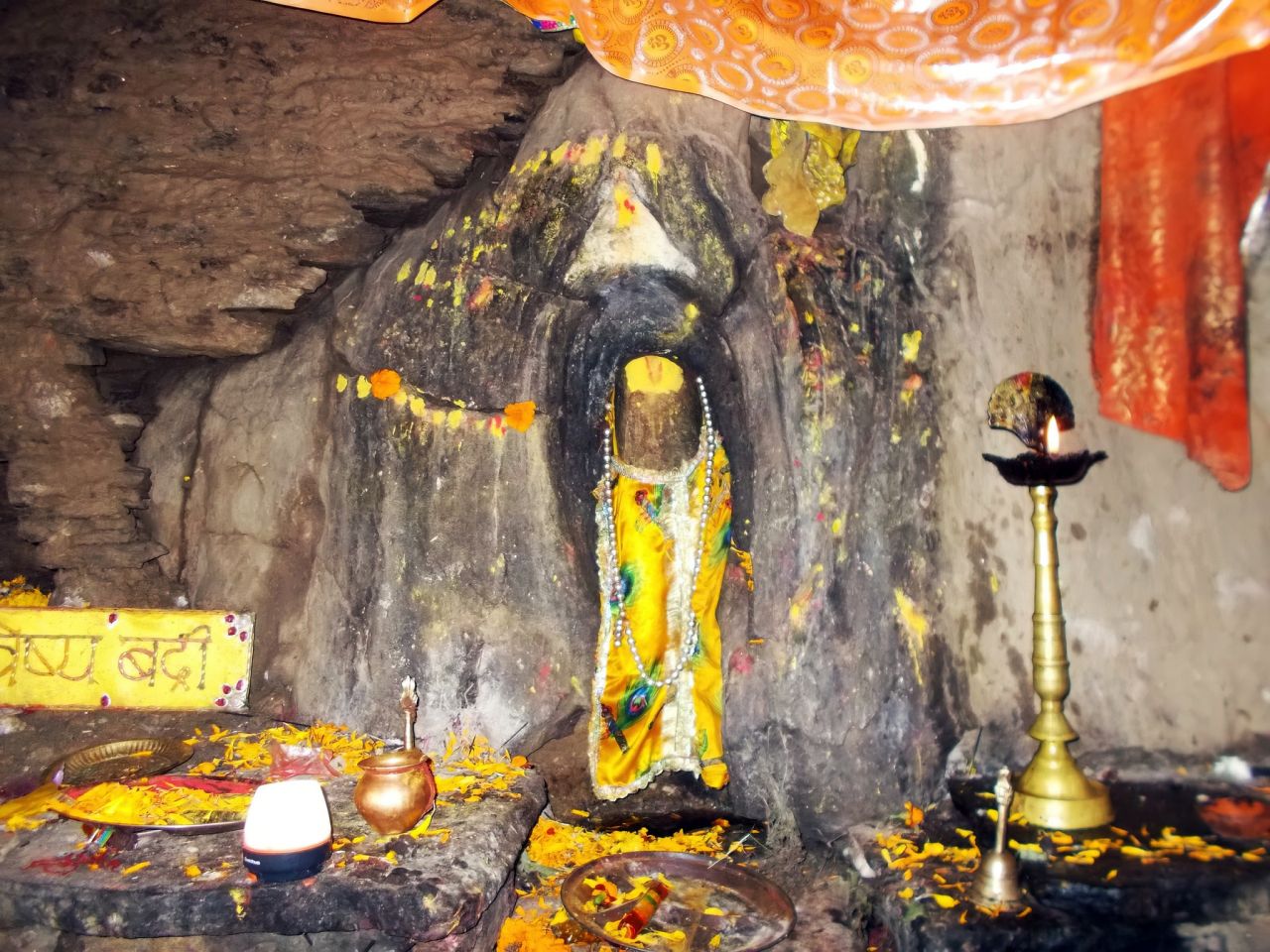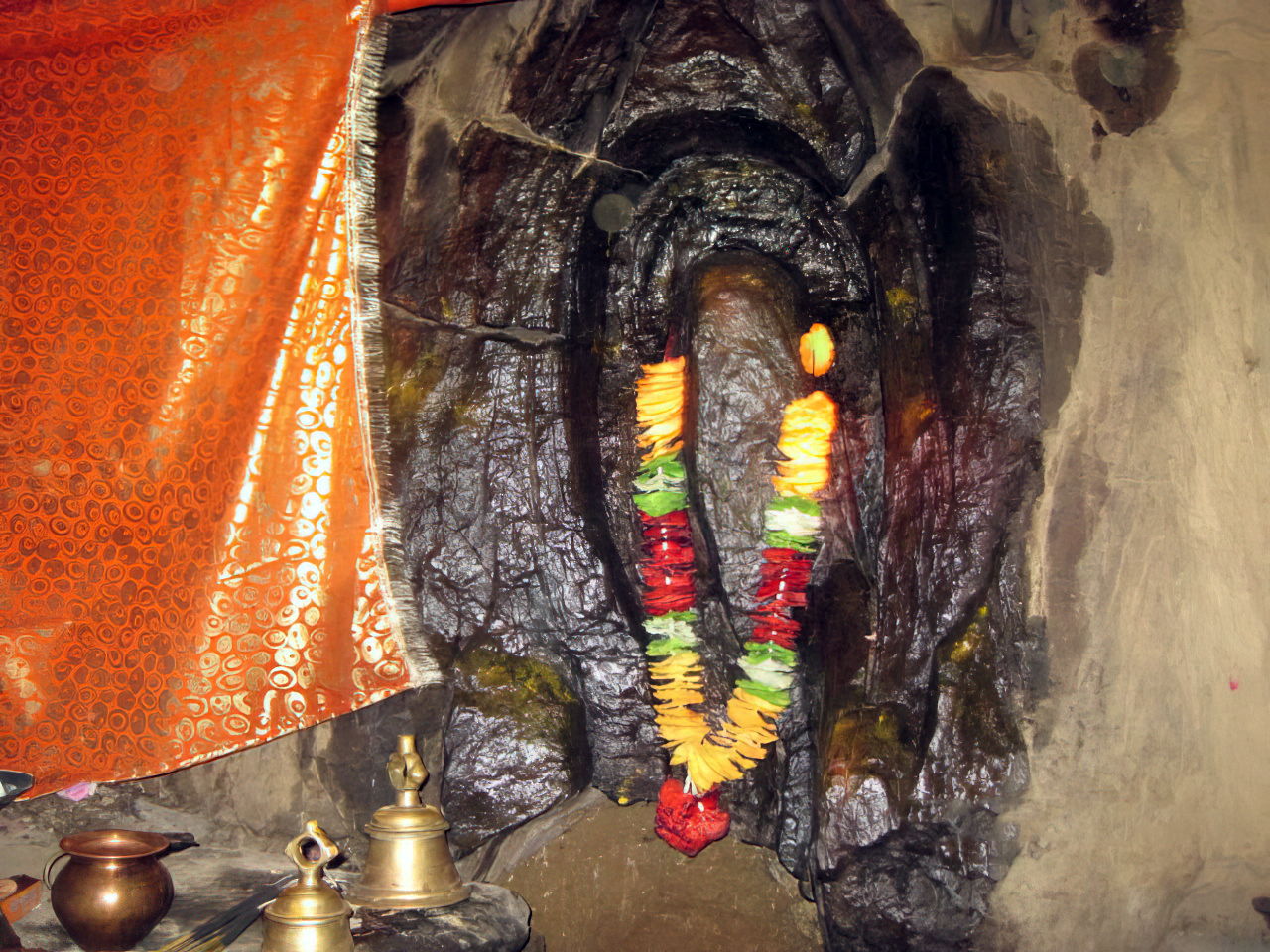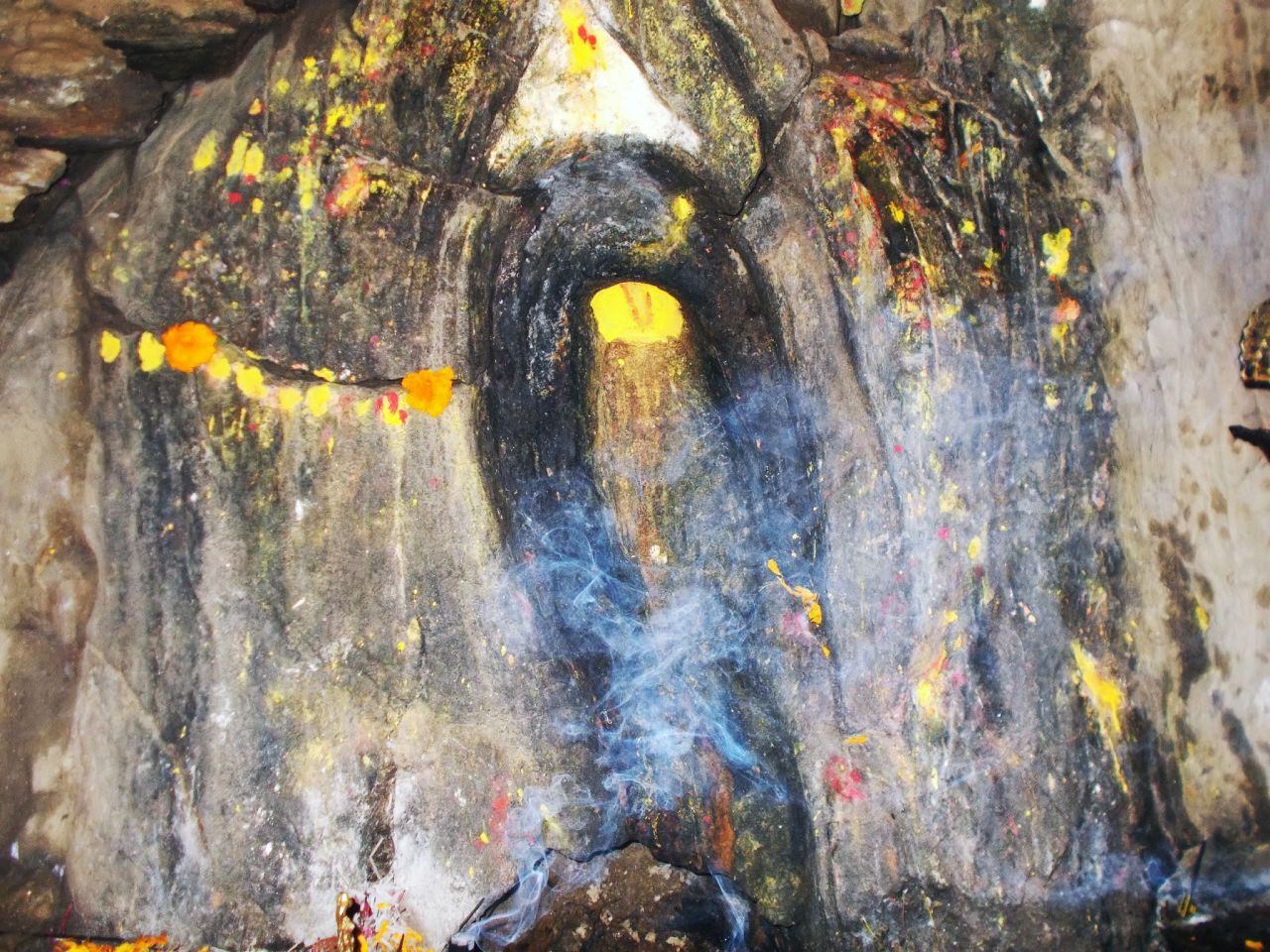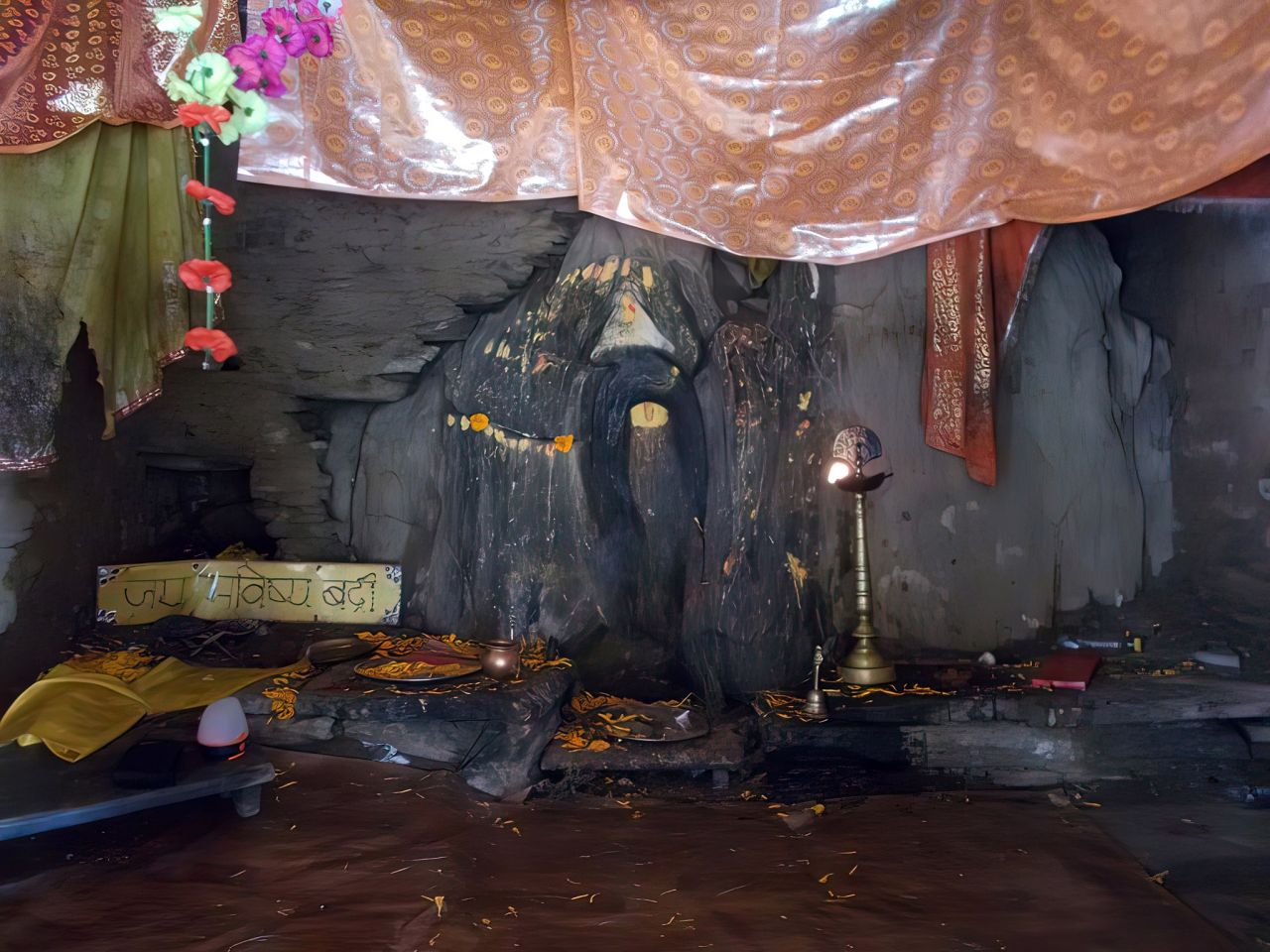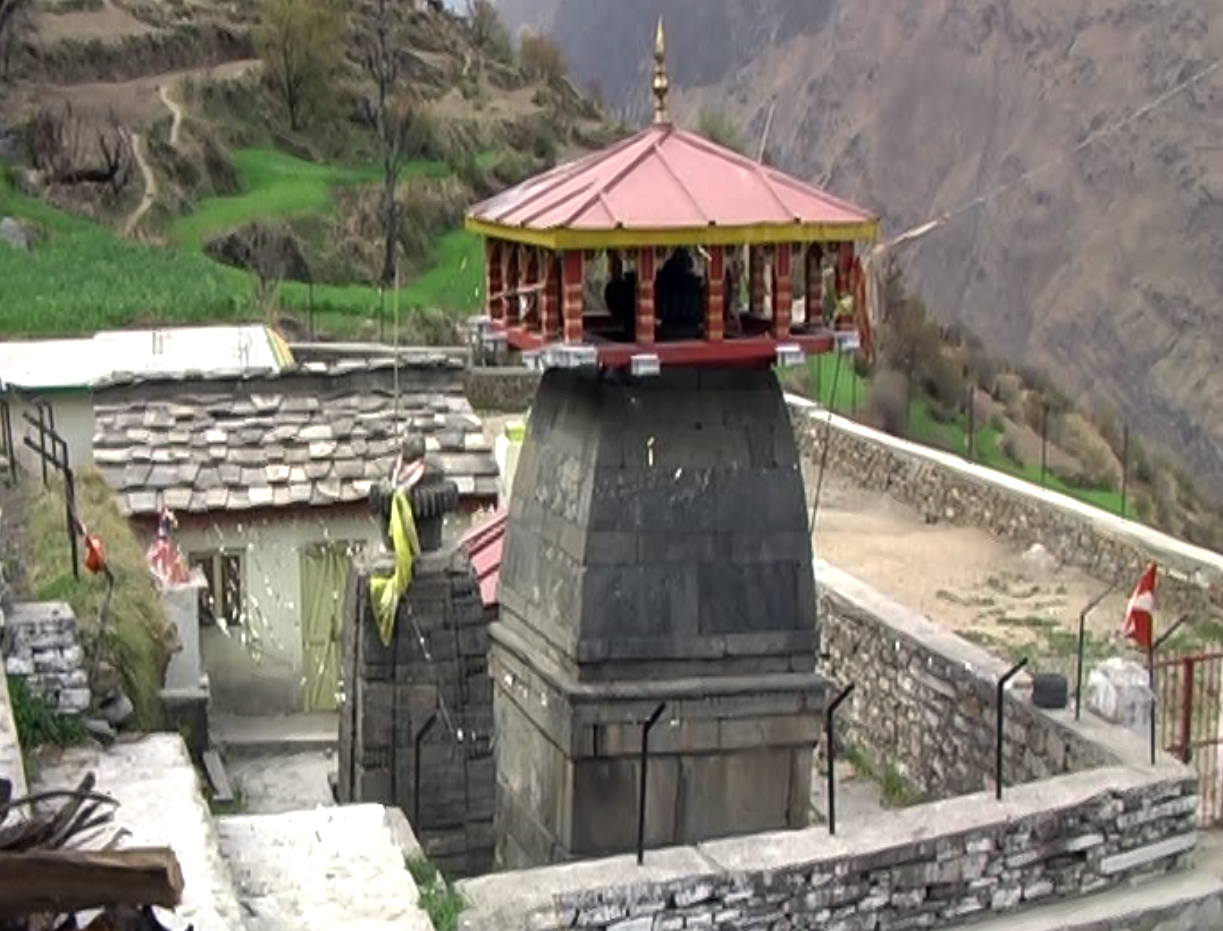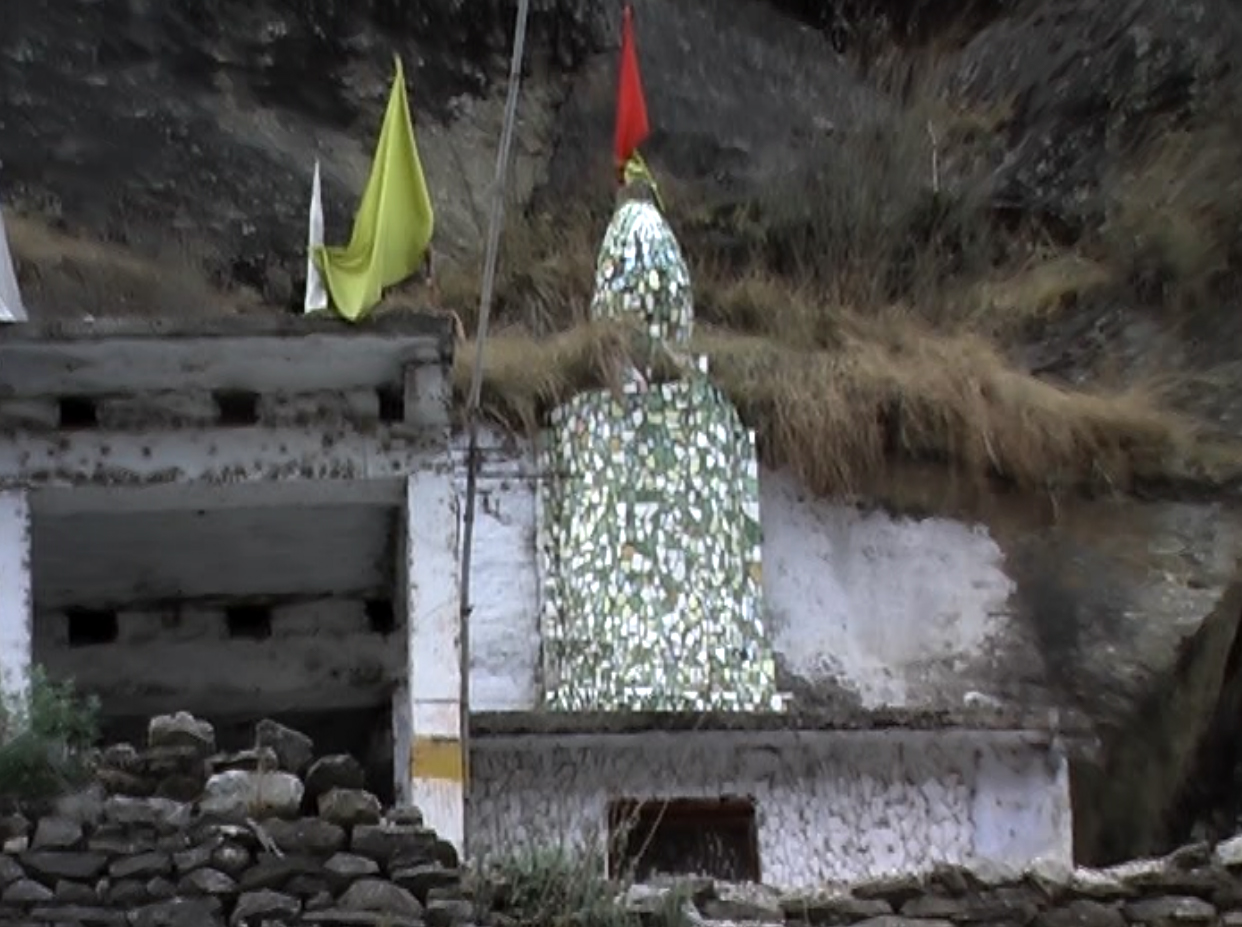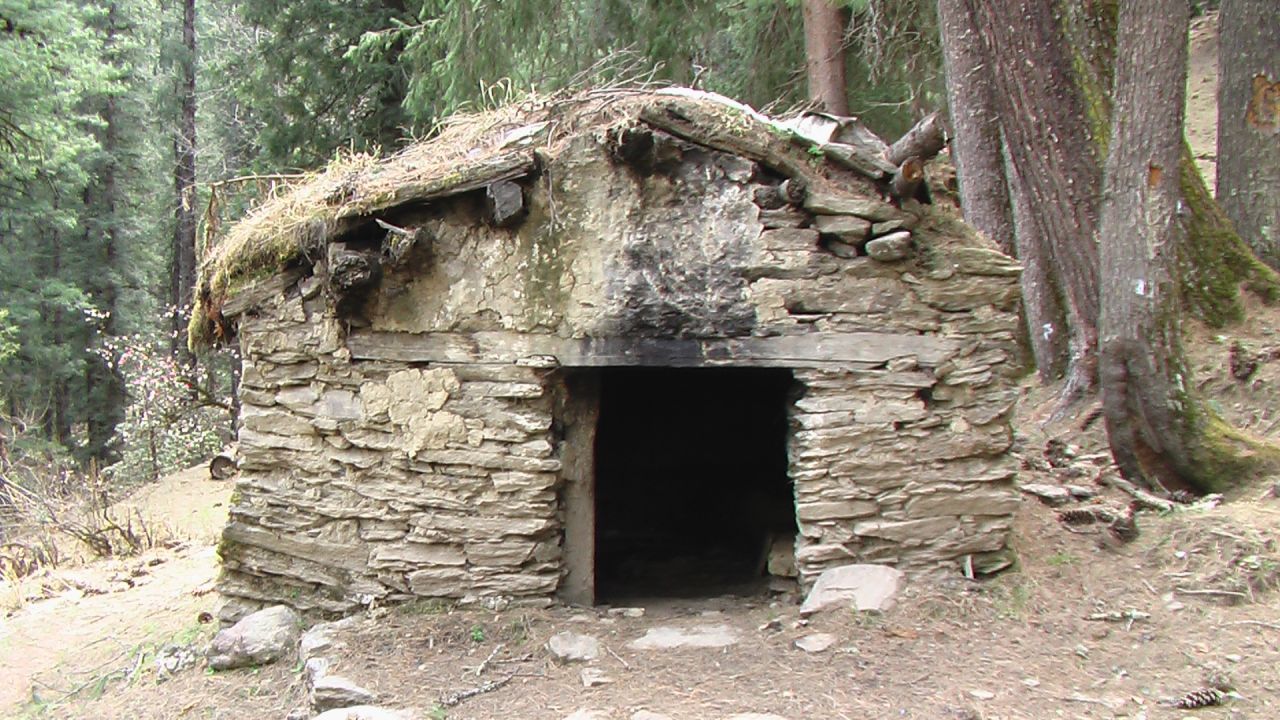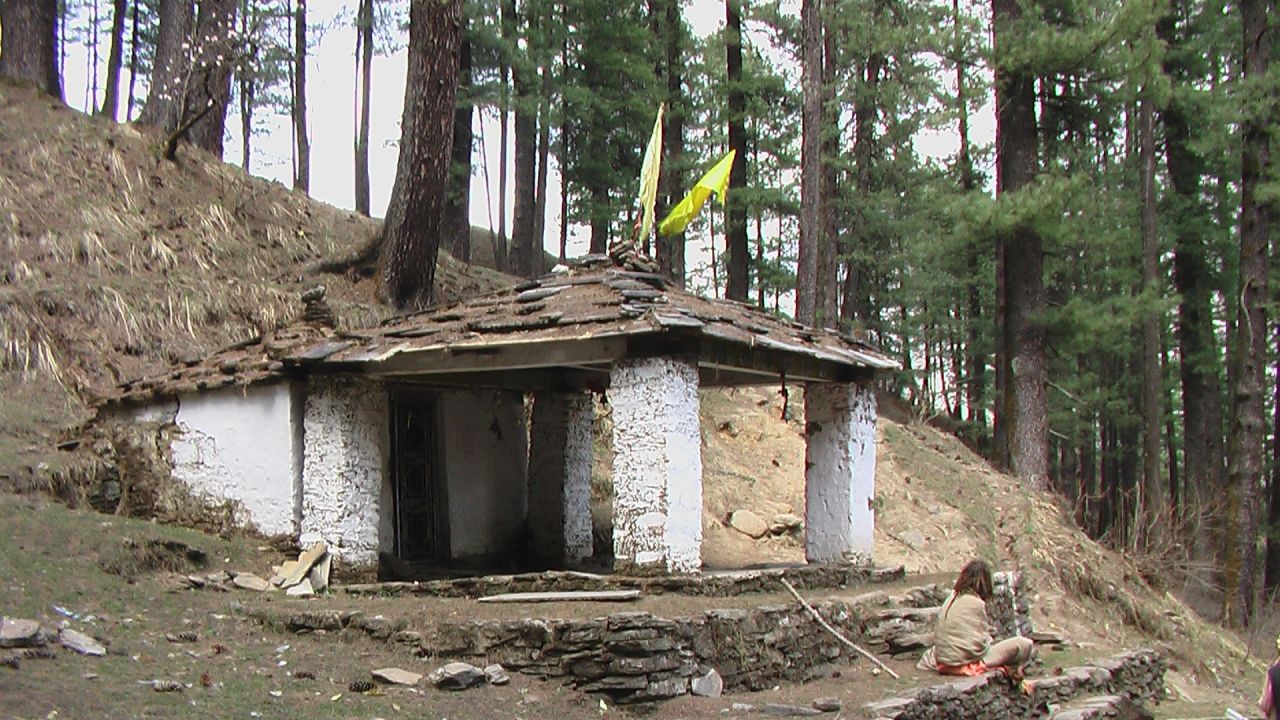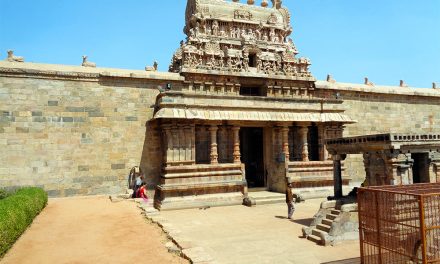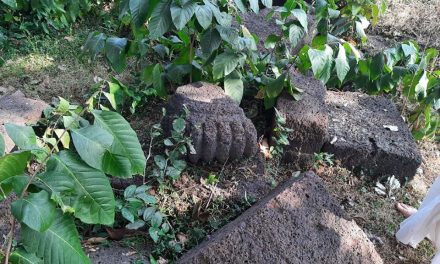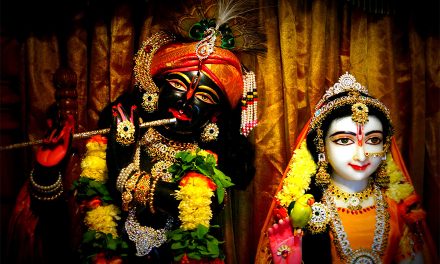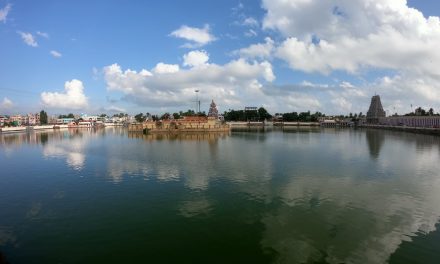In the last few days there have been many news reports of cracks appearing on roads and buildings at Joshimath near to Badrinath. Even the ancient Narasimha temple established by Adi Shankaracharya is said to be cracking.
Seeing these news reports I thought to repost what I wrote in 2013 about the prophecy of the Joshimath Narasimha deity breaking and Bhavishya Badri (the “future Badrinath”) manifesting. These were told to me by sadhus who stayed at Tapovan and Bhavishya Badri back in 2008.
Here is one of many recent news articles highlighting the cracks appearing in buildings throughout Joshimath:
Hundred of houses and buildings have begun developing cracks throughout the city. Even the crystal shivalinga in one of the local temples has cracked.
Seeing these news articles, I was immediately reminded of the stories told to me by sadhus who stayed at Tapovan and Bhavishya Badri back in 2008. These are ancient prophecies that have been handed down from sadhu to sadhu for thousands of years from the time of Adi Shankaracharya.
A few years prior to meeting these sadhus at Bhavishya Badri we had been advised to visit Tapovan by a sadhu we met in Badrinath, named Swami Balakrishna Giri. He was originally from Kerala but had been living as a sadhu in the Himalayas for 40 or 50 years at this point. This was perhaps in 2003 or 2004, though I don’t remember the exact date. The story of meeting him and what he told us in the few hours we saw him is itself interesting, but I will save that for another article. I will give just a brief description of how I met him as I don’t want to go further off topic.
As we were sitting in the bus at Badrinath, preparing to return to Rishikesh, there was just one seat empty which happened to be the seat next to me. The bus engine started, and the bus started driving out of the bus stand, but just before leaving a sadhu jumped into the moving bus and came to sit next to me in the last empty seat. This was my first encounter with Swami Balakrishna Giri. He began talking to me and explaining where he was from and how he became a sadhu, and many topics about the Himalayas and the sadhus who wander there like himself.
In those days the road from Joshimath to Badrinath was very bad, and only one way traffic was allowed at a time. Even though it was a short distance it took hours to travel it, and there were constant land slides disrupting the traffic. In this case it was our good fortune as I got to spend a few hours hearing from Swami Balakrishna Giri. I had come on this trip to the Himalayas with many questions in my mind, but spontaneously this sadhu was answering them without me even asking them. To me it was miraculous, how one by one he led the conversation to answer the questions I had inside before I could even ask them.
As we got closer to his destination, I finally brought myself to ask him the one last question that remained, “Where and how can we meet siddha purushas (perfected beings) in the Himalayas like we read about in some books.”
He replied, “I have been wandering the Himalayas searching for the same siddha purushas for the last 50 years, living as a sadhu, and still I have not met them. How will you be able to meet them by spending a few weeks visiting these places?”
Then after a pause, maybe feeling some compassion for us, he said, “Go to Tapovan. There is a sadhu staying there who is the highest I have come across in my 50 years of wandering in the Himalayas. He is known as Nath Baba, and he stays at the Devi temple in Tapovan. He is the closest I have come across to what you are asking about. Sometimes we ask him if we can take him to Badrinath for darshana, and he replies ‘I can see the entire universe sitting here, why should I go with you to Badrinath. I am already seeing Badrinath sitting here itself.’ ”
At that point the bus reached to Joshimath, and Swami Balakrishna Giri got down. I really wish I could have followed him to Tapovan that day, but at that point we were on our way back to Odisha, having already spent a couple months in the Himalayas on tirtha yatra. I promised him we would come to Tapovan to see him in the future.
Three or four years went by and in 2008 we again got the opportunity to come to Badrinath for tirtha yatra. All these years we kept remembering what Swami Balakrishna Giri had told us about Nath Baba who lived at Tapovan, and we had a strong desire to meet this saint. Nath is one of the sampradayas sadhus follow, coming in the line of Gorakh Nath and other mystic saints. I assume it wasn’t his proper name, but rather what the locals called him since he was a sadhu in the Nath sampradaya. Sadhus are generally not known by their actual names, but by some simple characteristic which identifies them.
This time we made a specific plan to get down at Joshimath and go towards Tapovan to try to find this Nath Baba. Unfortunately when we got there and inquired we were told the saint had gone to Karnaprayag to visit the Uma Devi temple there, and may not be back for weeks or months, as per his feelings. Swami Balakrishna Giri was also not present, probably having gone with Nath Baba to Karna Prayag.
A bit disappointed that our trip was a failure and we were not going to be able to meet the Nath Baba, whom we were waiting several years to see, we went back to the bus stand and sat in a tea stall. We decided having come so far we would at least try to go visit Bhavishya Badri, located 17 km up in the mountains from Tapovan, one of the seven Badris (Sapta Badris) in the Himalayas. While sitting there in the tea stall, a local sadhu asked us where we were going and we replied that we were planning to go to Bhavishya Badri.
He said, “You will get lost if you go alone, I’ll come along and take you there.” Then he walked with us for 17 km to Bhavishya Badri, the whole way telling us the history of each place. At the top, he introduced us to the sadhus who stay at Bhavishya Badri permanently, and we got to hear many interesting stories from them about sadhu life in the Himalayas.
We were visiting Bhavishya Badri from our ashram in Odisha, and when we got to the top of the mountain after a 17 km walk we saw the Odiya “Anakara” symbol (of Achyutananda sampradaya) painted on the wall and found Odiya sadhus were staying there. It was like arriving back at home.
Above is one of the sadhus who stays at Bhavishya Badri throughout the year. This sadhu was from Odisha and belonged to Achyutananda sampradaya (pancha sakha).
In the prior picture above, the stick I am holding is known as “tejbal”. It was just given to me by the Odiya sadhu at Bhavishya Badri. He had been given it by a mad sadhu a few days before at Tapovan. Years later after we made our Panchamukha Hanuman temple in Chennai the stick was kept with Lord Hanuman on the altar, where it remains.
Branches of this tree are used by sadhus because they repel snakes and other negative energies (like ghosts). They have some type of subtle energy that does not allow snakes to come close to it. Also if there is a snake bite you can take one of the thorns and grind it into a chandan paste. Then you apply the paste onto the bite and also eat some of it as an antivenom treatment. This was one of the things explained to me by the sadhus at Bhavishya Badri.
At the time, all the mountain peaks surrounding us were covered in snow, as you can see in the photo above. Though they look close, they are actually many kilometers away. The sadhus pointed to one particular snow covered peak and said, “On that mountain there is a mischievous gandharva. He likes to harass the sadhus. One time while flying past our ashram, he picked up one of our sadhus and left him on that mountain over there. We didn’t find him for three days, and when we finally found him, his mind was gone and he was walking in a daze. He was never the same after that.”
After spending some time with the sadhus, the same sadhu who brought us to Bhavishya Badri also took us back down to Tapovan, again walking 17 km with us. He was such a kind sadhu, and he took so much effort to help us, without any remuneration or anything. Luckily I was able to get a few photos on that trip along with this sadhu, though I no longer recall his name. Recently when looking at videos on youtube of Bhavishya Badri I was surprised to see that Baba is still living there today 15 years later.
I have already gone a bit off track with these remembrances, so let me come back to the original topic, which are the prophecies of Joshimath and Bhavishya Badri as told to us by these sadhus.
There is an ancient prophecy by Adi Shankaracharya that the arm of the Narasimha deity in Joshimath (located a short distance below Badrinath) will become thinner and thinner each year. When the arm of the Narasimha deity in Joshimath breaks, at that time the Himalayas will collapse and the present Badrinath will be lost.
A new Badrinath will be located at Bhavishya Badri, where 50 years ago a siddha found the location where a large boulder in the mountain is slowly manifesting a deity of Badri Narayana on its own (a self manifesting deity). The following photo shows the small temple made over the cave with the Badri Narayana deity manifesting.
Each year the deity is manifesting more and becoming clearer. Some sadhus stay at this isolated place throughout the year, even in the thick snows of winter, waiting for when the prophecy is completed. At present the arm of the Narasimha deity at Joshi Math is as thin as a hair, and any moment it may break. After seeing recent news articles of many buildings in Joshimath developing huge cracks, my remembrance of these stories were triggered.
The pictures below are of the future Badri Narayana. The deity is actually about 1 foot inside the boulder, but you cannot see the depth in the photo.
There is a wonderful story about how a local saint discovered this spot where the deity was manifesting. The general area of Bhavishya Badri was already known, as Adi Shankaracharya had established another temple in a nearby village to mark the area, but the exact location of the future Badri temple and deity wasn’t known.
One sadhu used to come and spend the winters in a remote place on a mountain top next to a granite boulder protruding from the mountain. He had taken the vow to never use fire, neither for cooking, nor for heating, nor for light.
His sadhana was stitching quilts and chanting Rama’s name for each stitch he sewed into the quilt. For this reason he was given the name Gudari Baba, (“Patchwork Baba”), as he carried a patchwork quilt wherever he went. It has been said that his quilt weighed around 50 kilos, and he carried it everywhere he went throughout the Himalayas. Though he is not remembered today, in his time, 60 or 70 years before, he was known among the Himalayan sadhus as one of the very advanced siddhas in their community. Very few photos of him remain.
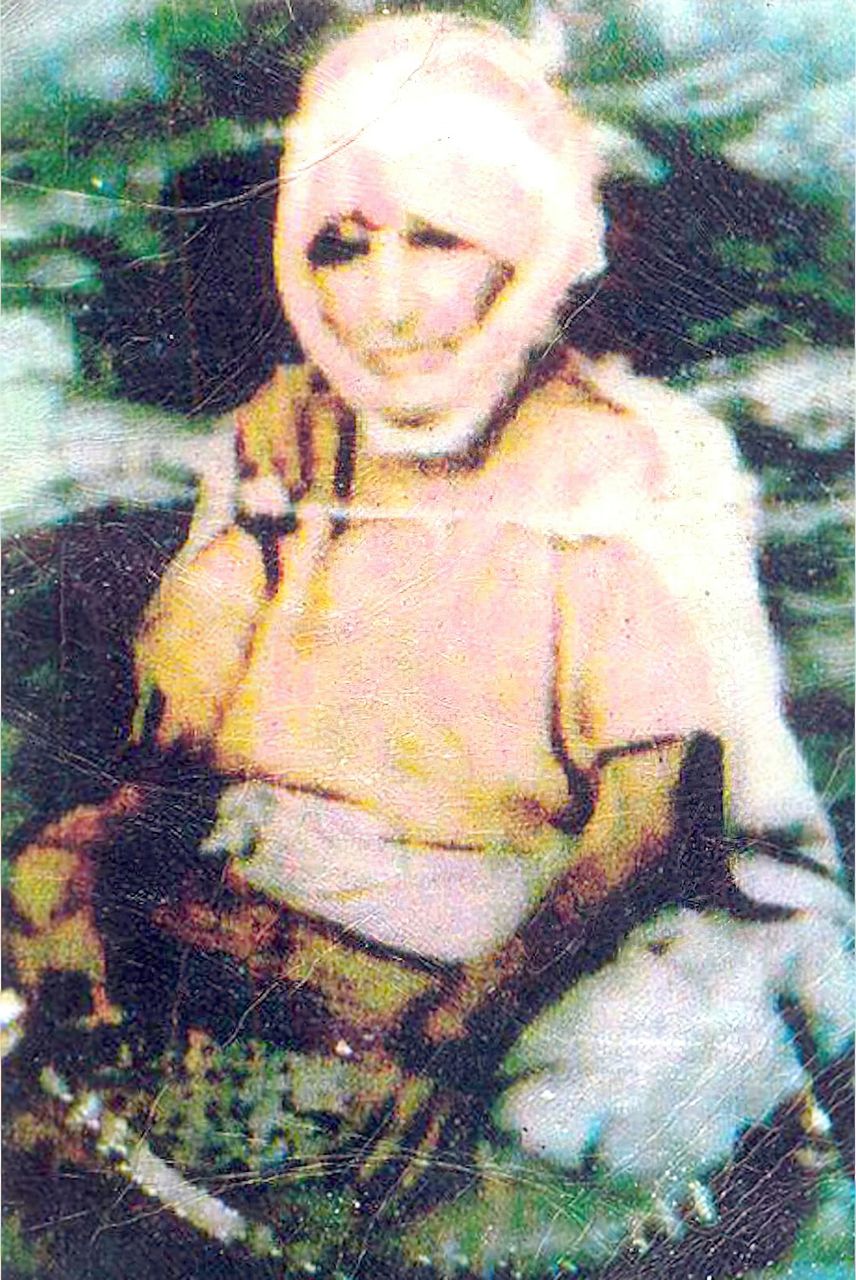
Extremely rare photo of the saint Gudari Baba.
He would spend six months of the year a little further down the mountain during the summer, and then for six months he would come alone up to this spot that we know today, where the Badri Narayana deity is manifesting. He would perform severe tapasya and sadhana each year for six months in the snow at the spot where the boulder is, before anyone knew what it was.
For food he would prepare raw chapatis in the summer and keep them in the sun for many days till they became completely dry. Afterwards he would eat those in the winter when there would be many feet of snow around him and he couldn’t move around or even go outside. For decades he was coming alone to this spot, and his tiny kutir, maybe 4 feet square, is still visible next to the boulder.
No one knew why he was choosing to come to this remote place for sadhana in the most difficult season, covered in snow, with no food or fire for warmth, simply chanting the names of Rama. After he entered samadhi the local sadhus saw the deity of Lord Narayana manifesting little by little inside the boulder where he did tapasya, increasing year by year. That is when they understood why he was coming there, and how he had discovered the location of Bhavishya Badri and the self manifested deity of Badri Narayana that was prophesized by Adi Shankaracharya.
As years went by, the deity grew and became more visible. They say He will continue to manifest and become fully visible when the present Badrinath temple is destroyed by a natural disaster and shifts to this location. Adi Shankaracharya had established a temple further down the mountain to indicate the general location of the future Badri, but till this sadhu located the spot through his inner meditation, no one knew the exact location where the new Badrinath temple would manifest.


